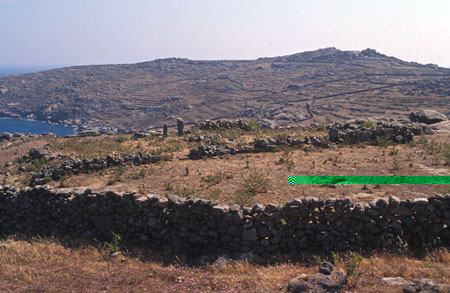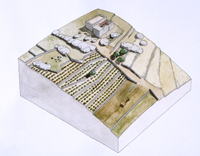To the north and south of the ruins of the town, the Delian countryside preserves numerous remains that bear witness to the efforts made to make the most of the island’s rural areas. Nevertheless, the Delians did not cultivate territory on Delos alone; from the time of its consecration to Apollo by Polycrates of Samos (c. 525; see Delos in the Archaic period) onwards, a part of Rhenea (the exact extent of it is not known) belonged to the city and, from the middle of the third century, the god also possessed lands on Mykonos.
Our knowledge of the land is dependent on two types of course, which happen to be broadly complementary:
- On the one hand, the countryside, which is still laid out as it was in antiquity, gives us information about the principally agricultural and pastoral practices that formed it.
-
On the other, inscriptions tell us about a specific legal category of properties, the temene, which were managed by the magistrates responsible for the god’s estates.
These epigraphic texts allow precise analysis of the legal aspects and socio-economic role of leasing in the city during the Independent period, and they also provide a certain amount of information about the types of cultivation practised in conjunction with livestock farming, and about the buildings on sacred land, although neither an architectural reconstruction of the farms nor a specific identification of the location of the god’s farming operations is possible.
The remains of the ancient agrarian landscape
This landscape is very homogeneous and uniform as, from the time of its ‘construction’ (which is dated to the end of the Archaic era) to its abandonment, its size remained the same, although from the second half of the second century the land available to agriculture was reduced by urban development.
Taking into account the environmental characteristics, the organisation of the land was effectively designed from the beginning for the practice of a subsistence polyculture closely linked to livestock farming. The two northern peninsulas were used solely for grazing; apart from a few gneiss quarries and a lighthouse (79.2), there have been found there only large rectangular enclosures equipped with a water source and adjoined by sheepfolds. Conversely, to the east and south of the town, on the slopes of the town’s two ranges of hills, there extended areas of terraced terrain intended for agriculture, with small-scale granite quarries in places.
-

-
Farming terraces in the southeast of the island
A network of paths determined travel, closely linked to topography: from the top of the Theatre Quarter a main thoroughfare in a north-south direction (of which the outline remains today) formed a sort of spinal column in the centre of the island, from which stemmed paths leading to isolated farms and making it possible to move between the groups of tiered fields.
About a dozen farms, spread between the various different drainage basins, were dispersed throughout the southern half; an examination of shards from the surrounding ground shows that none of these dwellings was occupied after the first century BC. A desire to make the best use possible of the land determined where they were established: they are generally found on shelves that are high up, in places where the rock is bare. They are generally single-block houses (128), with shelters for livestock in their immediate vicinity and in some cases an area for dehulling cereals. It is notable that none of them has a tower, although in the same period throughout the whole Archipelago the pyrgos was a constant feature of the great majority of isolated dwellings. The inviolability that in ancient times protected all sanctuaries extended on Delos to the whole island, which explains the absence of defensive works in the landscape as well as the rampart around the town.
-

-
Farm 128 and the approach to it: restored view
Regardless of the gradient of the slopes (which is sometimes very slight), the terraced fields are in groups separated by paths, which follow and mark out the main axes of the landscape. In some areas, they take the form of long, wide beds that could have been ploughed by a pair of oxen, while elsewhere there are only narrow banks more suited to arboriculture.
The farming terraces, which consist of flat surfaces that promote the widespread absorption of precipitation, even today play an essential role in protecting the environment against erosion. Nevertheless, an essential corollary of these arrangements was the hydraulic installations that were intended to prevent heavy flows in the form of devastating torrents as well as to store water for the purposes of irrigation. So in some places reservoir basins built for this double purpose have been found, which were the starting points for the gravity irrigation networks. These hydraulic systems, which were complemented by many wells, allowed the Delians to work around the very restrictive cycle of dryland farming and extend the range of crops they cultivated to types of trees and garden species that required water. The irrigated plots forming kepoi, that were near farms or found within open fields sown with wheat, had to be protected at all costs against wandering herds, and so they were enclosed by stone walls, just as all the island’s paths taken by livestock were fenced with stone walls.
But while small parts of ancient plots of agricultural land have been preserved in this way, we know absolutely nothing of the plots of real estate and how they were developed over time; in accordance with what generally was the case in ancient Greece, the boundaries of rural properties were very likely denoted by markers (which was not necessarily inscribed) that today have disappeared or are difficult to identify. As a result it is impossible to estimate the number of farming operations (all of which did not have farm buildings) or their size (moreover, they did not necessarily belong to one owner), still less distinguish those that belonged to Apollo (see The real estate and property of Apollo).
Cultivation and livestock raising: polyculture for food production
The lease contracts that have come down to us in inscriptions reflect only very incompletely the variety of food-producing agriculture on Delos, which the remains of agricultural organisation allow us to understand better. Indeed, the brief inventories that go with the leases mention only countable crops, i.e. fruit trees (chiefly fig trees) and vines, and do not shed light on all the forms of cultivation that were practised as part of biennial crop rotation, cereals (especially barley) and pulses, which formed most of what the land produced. Vine-growing was evidently more developed on Rhenea than on Delos but it seems to have been favoured for a long time on the two islands at the expense of oil-growing. It is, however, possible that the cultivation of olive-trees advanced a little under the second Athenian domination, since there were several small-scale oil-works (121.2) in the first-century town.
The hiera syngraphe of 300 distinguishes two groups of sacred properties, according to whether livestock were raised on them or not. In fact, according to the inventories, some farms were endowed with a sheepfold and a cowshed (which could hold only the pair of oxen needing for ploughing). Literary texts also describe the rearing of capons as a Delian speciality.
Given the lack of information about the total area of farmed land and the proportions of it reserved for each type of cultivation, it is impossible to estimate the outputs or the level of profitability of the holdings, however they were farmed. Nevertheless, the fees owed, which fluctuated over time owing to a range of different factors that are difficult for us to grasp (the vagaries of the climate along with variations in both local and regional conditions), were generally quite high, which suggests that agriculture was certainly profitable in the Independent period. It can be reckoned that during this time the products of Delian farming met a large part of the needs of the population, which was still limited in number. However, from the second half of the second century, agriculture almost certainly became for around a century an activity that could no longer claim to satisfy the demands of a very numerous population, but rather provided small-scale processing industries situated in the town, perfumeries and oil-works.
Subsequently, and until the island was abandoned, food-producing polyculture was once again practised by the small community of peasants who lived gathered in a section of the Hellenistic town. Although it was only in these later eras that evidence of vine-growing in the form of wine presses set up in the urban area (121.1), this is surely because previously the yields of small vineyards were processed on an individual scale in the different farms in the area, with more rudimentary machinery that left no trace in the properties.
© EfA / M. Brunet
